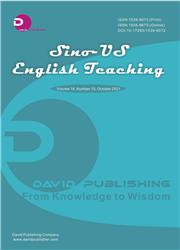Howl: A Poetry-Movie Bridging Spontaneous Poetry and Avant-Garde Film
引用次数: 0
Abstract
In the 1950s, McCarthyism, characterized by anti-Communist and anti-foreign policy, was rampant throughout the United States of America. The public recitation of the poem “Howl” marks the beginning of the Beats’ rebellion against McCarthyism. As a successful poetry-movie, the film Howl bridged the gap between vision and hearing through a series of diversified presentation forms, such as documentary reenactments, archival photos, and the reconstruction of court trial scenes, thus breaking the boundary between poetry and film. As a kind of displaying the authorship of Ginsberg, the close-up pictures of typewriters repeatedly appear in the film to vividly interpret the Beat writers’ style of spontaneous composition. most you heard he was was the carriage slamming back again and again. The little would bing-bang, bing-bang, bing-bang! incredibly fast, faster than a teletype … Then he’d make a mistake, and this would lead him into a possible part of a new paragraph, into a funny riff of some kind that he’d add while he was in the process of copying. maybe he’d a page of the notebook and he’d look at that page and it was no good and he’d X it or maybe part of a little bit and turn another the whole thing, and from something would—again, he would and laugh and豪尔:一部连接自发诗歌和先锋电影的诗歌电影
20世纪50年代,以反共和反外交政策为特征的麦卡锡主义在整个美利坚合众国肆虐。公开朗诵诗歌《嚎叫》标志着披头士乐队反抗麦卡锡主义的开始。作为一部成功的诗歌电影,电影《嚎叫》通过纪录片重演、档案照片、庭审场景重构等一系列多样化的呈现形式,弥合了视觉与听觉的鸿沟,从而打破了诗歌与电影的界限。作为对金斯伯格作者身份的一种展示,电影中反复出现打字机的特写画面,生动地诠释了垮掉派作家自发创作的风格。你听到的最多的是马车一次又一次地颠簸着回来。小家伙会砰,砰,砰!难以置信的快,比电传打字机还快……然后他会犯一个错误,这会导致他进入一个新段落的可能部分,进入一个有趣的即兴片段,他会在复制的过程中添加。也许他有一页笔记本,他会看那一页,但它不好,他会把它X掉,或者可能是一部分,然后把另一页翻过来,然后从某件事开始——再次,他会笑
本文章由计算机程序翻译,如有差异,请以英文原文为准。
求助全文
约1分钟内获得全文
求助全文

 求助内容:
求助内容: 应助结果提醒方式:
应助结果提醒方式:


